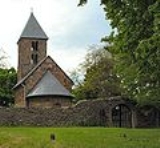
Nagybörzsöny
Encyclopedia
Nagybörzsöny is a village in Pest
county, Hungary
.
.jpg)
Mountains. In the vicinity we can find the National Park of Duna-Ipoly. The Börzsöny-creek flows through the village.
officially discovered the element Tellurium in the Nagybörzsöny ores. Two other Hungarians were also noted for their research of the element. In 1782, Franz-Joseph Müller von Reichenstein
, otherwise known as (Müller Ferenc), independently named the element. A third Hungarian who also laid claim to Tellurium was Ignaz von Born. Muller was from Sibiu/Nagyszeben in what is now Transylvania, and von Born worked in Vienna. In 1798, the new element was named by Martin Heinrich Klaproth
; the name is derived from the Latin word "tellus", meaning earth. Tellurium has thermoelectric applications, and was used in alloys within the steel
industry. The element eventually played an important role in the making of the outer shell of the first atom bomb.
Pest (county)
Ethnic groups :*Magyars - 93.5%*Germans - 1.7%*Roma - 1.2%*Slovaks - 0.8%*Others - 0.5%*Unknown - 2.3%Religions :*Roman Catholic - 53%*Calvinist - 16%*Lutheran - 3.8%*Greek Catholic - 1.2%*Others - 1.3%...
county, Hungary
Hungary
Hungary , officially the Republic of Hungary , is a landlocked country in Central Europe. It is situated in the Carpathian Basin and is bordered by Slovakia to the north, Ukraine and Romania to the east, Serbia and Croatia to the south, Slovenia to the southwest and Austria to the west. The...
.
.jpg)
Location
Nagybörzsöny is a village in the BörzsönyBörzsöny
Börzsöny is a mountain range in Northern Hungary. Its tallest peak is the Csóványos with 938 metres.It is the westernmost member of the North Hungarian Mountains, which in turn are part of the Inner Western Carpathians. The varied landscape offers good hiking opportunities. A large part of the...
Mountains. In the vicinity we can find the National Park of Duna-Ipoly. The Börzsöny-creek flows through the village.
History
The earlier name of this village was Börzsöny and was, in all probability, founded in the 12th century by King Géza II of Hungary. In medieval times, it was able to grow into a full-fledged mining town due to its proximity to various ores, including gold. Documents dating from 1312 already describe these mines. However, the most significant part in the mines' history took place in the eighteenth century. In 1789, Pál KitaibelPál Kitaibel
Pál Kitaibel was a Hungarian botanist and chemist.He was born at Mattersburg and studied botany and chemistry at the undersity of Buda. He became professor taught these subjects at Pest in 1794...
officially discovered the element Tellurium in the Nagybörzsöny ores. Two other Hungarians were also noted for their research of the element. In 1782, Franz-Joseph Müller von Reichenstein
Franz-Joseph Müller von Reichenstein
Franz-Joseph Müller Freiherr von Reichenstein or Franz-Joseph Müller von Reichenstein was an Austrian mineralogist and mining engineer. Müller held several positions in the Austria-Hungarian administration of mines and coinage in the Banat, Transylvania, and Tyrol...
, otherwise known as (Müller Ferenc), independently named the element. A third Hungarian who also laid claim to Tellurium was Ignaz von Born. Muller was from Sibiu/Nagyszeben in what is now Transylvania, and von Born worked in Vienna. In 1798, the new element was named by Martin Heinrich Klaproth
Martin Heinrich Klaproth
Martin Heinrich Klaproth was a German chemist.Klaproth was born in Wernigerode. During a large portion of his life he followed the profession of an apothecary...
; the name is derived from the Latin word "tellus", meaning earth. Tellurium has thermoelectric applications, and was used in alloys within the steel
Steel
Steel is an alloy that consists mostly of iron and has a carbon content between 0.2% and 2.1% by weight, depending on the grade. Carbon is the most common alloying material for iron, but various other alloying elements are used, such as manganese, chromium, vanadium, and tungsten...
industry. The element eventually played an important role in the making of the outer shell of the first atom bomb.
Sightseeings
- The main attraction of the village is an architectural one: The Árpád age romanesqueRomanesque architectureRomanesque architecture is an architectural style of Medieval Europe characterised by semi-circular arches. There is no consensus for the beginning date of the Romanesque architecture, with proposals ranging from the 6th to the 10th century. It developed in the 12th century into the Gothic style,...
church of Szent István-templom, built in the 13th century. The church is surrounded by walls. - Saint Nicolaus church
- Church of the miners. Gothic styleGothic architectureGothic architecture is a style of architecture that flourished during the high and late medieval period. It evolved from Romanesque architecture and was succeeded by Renaissance architecture....
, built in the 14th century - Evangelic church classicist style, built in the 18th cebtury
- Watermill: industrial memorial

